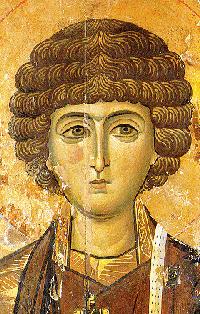
 The two basic methods of icon restoration differ in the degree of restorers' intervention into the material structure of the work. The first method, a simple "renewal" of the icon, is non-destructive and is most often used on lightly damaged icons. The losses in the ground are filled and the surface of the icon is partially or completely repainted over the old varnish. Sometimes, the entire surface of the old icon is
covered with the new ground. The new ground covers the original composition so well that sometimes a completely different composition is painted over it. After several centuries, such an icon becomes a "carrier" of many clearly distinguishable layers
which can be separated and removed.
The two basic methods of icon restoration differ in the degree of restorers' intervention into the material structure of the work. The first method, a simple "renewal" of the icon, is non-destructive and is most often used on lightly damaged icons. The losses in the ground are filled and the surface of the icon is partially or completely repainted over the old varnish. Sometimes, the entire surface of the old icon is
covered with the new ground. The new ground covers the original composition so well that sometimes a completely different composition is painted over it. After several centuries, such an icon becomes a "carrier" of many clearly distinguishable layers
which can be separated and removed.
The second method of "restoration" is much more destructive because it is used whenever the icon has considerable losses of the ground and the color layer or when the varnish is too dark and needs to be removed. The bumps in the ground are cut out with a knife, and the painted surface is cleaned; sometimes, to make it smooth, the restorer rubs it with pumice. Then, the icon is repainted with fresh paints directly over the old painted surface and over the new fragments of the ground. As a result, the image on the icon turns into a mosaic of fragments from different centuries hidden under the fresh layer of paint. Even the best scientific restoration of such an icon cannot determine precisely when the overpainting was done and which fragments of the icon are still original.
Reconstructing the damaged fragments of icons, Russian and Soviet restorers have followed the following principles:
1. Complete restoration of the work to its original appearance. This principle has three distinct historical phases, each producing results of different quality:
naive repainting ("renovation")
complete restoration of iconography
scientific and artistically justified reconstruction.
2. Preservation of the original parts of the old work only. This principle contradicts the first principle and disallows any reconstruction of the losses. The restorer's intervention is limited exclusively to preservation of the surviving fragments of the work and to the removal of overpaintings.
3. Rejection of any visible additions by the restorers. It can be called a principle of archeological restoration because it obliges the restorers during their revealing of the original layer of paint to preserve, wherever possible, of various layers of overpainting. The result of such restoration is a monument of history of culture and not a work of art which embodies the idea and the genius of its author. The main principle of such restoration is to leave the previously repaired and restored fragments intact.
4. Reconstruction of the color and tonal unity of the composition. This principle, introduced and developed in the 1920-30s, remains the most popular today. In a restoration guided by this principle, the restorers try to recapture the original artistic unity of the work by developing the potential unity of the surviving fragments. The restorers' efforts should be restricted to the revealing of the possibilities hidden in the fragments themselves, without committing a historical blunder or aesthetically damaging the work. This principle requires that the fill-ins (restorations) be made easily recognizable but at the same time invisible from a distance optimal for the viewing of the work; otherwise the work's unity, which is the main objective of such a kind of restoration, will be destroyed. Therefore, the fill-ins should match the original parts of the work in luminosity and chromatic quality.
Today, with the help of computers, anyone can engage in the "restoration" of icons without fear of irretrievably destroying a magnificent work of art. Digital reconstruction allows us to take a "hypothetical" look at some of the most damaged icons. In the example at the top of this page, I have "reconstructed" the damaged face of St. George from the Dormition Cathedral in the Moscow Kremlin (11th-12th century). My "restoration" was mainly an attempt to reveal completely the facial features of the saint. Indeed, I discovered a face of such beauty and excellence that I would not hesitate to attribute the work to a master from Constantinople. As can be seen, the face of St. George bears close resemblance to the face of St. Panteleimon from an early 13th-century hagiographical icon from Constantinople. It is easy to notice similarities in the authors' rendering of the eyes, the brows, the mouths, the noses, and the characteristic ruddy right cheeks of both saints. Even though the icon of St. Panteleimon seems to be more refined and differs from St. George in the color scheme, the portraits of both saints appear to be the products of one school.
To show the painstaking process of this restoration, I kept taking off layer after layer of damages, saving my images in twelve separate files. When the "restoration" was completed, I combined the images into an animated GIF file: you see how the damage on the face of the saint disappears right in front of your eyes. [A.B.]
[Source: Bobrov].
